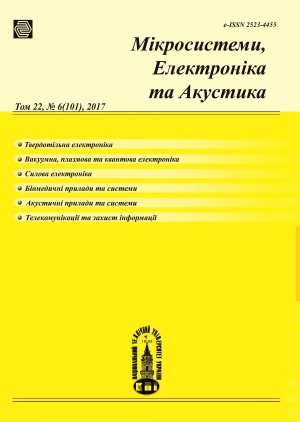Особливості фотолюмінесценції та спектрів пропускання тонких шарів пористого кремнію на діелектричних основах
Основний зміст сторінки статті
Анотація
В роботі проведено дослідження спектрів пропускання і фотолюмінісценції шарів пористого кремнію отриманих хімічним травленням з тонких плівок кремнію на основах з полі кору та сапфіру. Показано що характер спектру поглинання таких структур залежить як від умов отримання плівок кремнію так і від матеріалу основи. В результаті дослідження спектрів фотолюмінісценції що збуджувалась УФ-випромінюванням (285 нм) показано, що окрім характерних для пористого кремнію піків в області 600-700 нм в тонких шарах пористого кремнію спостерігаються піки в короткохвильовій області.
Бібл. 13, рис. 8.
Блок інформації про статтю

Ця робота ліцензується відповідно до Creative Commons Attribution 4.0 International License.
Автори, які публікуються у цьому журналі, погоджуються з наступними умовами:- Автори залишають за собою право на авторство своєї роботи та передають журналу право першої публікації цієї роботи на умовах ліцензії Creative Commons Attribution License, котра дозволяє іншим особам вільно розповсюджувати опубліковану роботу з обов'язковим посиланням на авторів оригінальної роботи та першу публікацію роботи у цьому журналі.
- Автори мають право укладати самостійні додаткові угоди щодо неексклюзивного розповсюдження роботи у тому вигляді, в якому вона була опублікована цим журналом (наприклад, розміщувати роботу в електронному сховищі установи або публікувати у складі монографії), за умови збереження посилання на першу публікацію роботи у цьому журналі.
- Політика журналу дозволяє і заохочує розміщення авторами в мережі Інтернет (наприклад, у сховищах установ або на особистих веб-сайтах) рукопису роботи, як до подання цього рукопису до редакції, так і під час його редакційного опрацювання, оскільки це сприяє виникненню продуктивної наукової дискусії та позитивно позначається на оперативності та динаміці цитування опублікованої роботи (див. The Effect of Open Access).
Посилання
A. Uhlir, "Electrolytic shaping of germanium and silicon," The Bell System Technical Journal, vol. 35, no. 2, pp. 333-347, March 1956. DOI: 10.1002/j.1538-7305.1956.tb02385.x
L. T. Canham, "Silicon quantum wire array fabrication by electrochemical and chemical dissolution of wafers," Applied Physics Letters, vol. 57, no. 10, p. 1046–1048, 1990. DOI: 10.1063/1.103561
V. A. Skryshevsky, "Basics of MIS-type gas sensors with thin nanoporous silicon," in IEEE 34th International Conference on Electronics and Nanotechnology, Kyiv, Ukraine, 2014. DOI: 10.1109/ELNANO.2014.6873967
T. Obukhova, "Porous silicon formation on solar cells surface," in IEEE XXXIII International Scientific Conference Electronics and Nanotechnology, Kiev, Ukraine, 2013. DOI: 10.1109/ELNANO.2013.6551993
P. Kumar, P. Lemmens, M. Ghosh, F. Ludwig and M. Schilling, "Effect of HF Concentration on Physical and Electronic Properties of Electrochemically Formed Nanoporous Silicon," Journal of Nanomaterials, vol. 2009, 2009. DOI: 10.1155/2009/728957
E. J. Anglin, L. Cheng, W. R. Freeman and M. J. Sailor, "Porous silicon in drug delivery devices and materials," Advanced Drug Delivery Reviews, vol. 60, no. 11, pp. 1266-1277, 17 August 2008. DOI: 10.1016/j.addr.2008.03.017
Y. Zhang, Z. Yang, D. Liu, E. Nie, X. Bai, Z. Li, H. Song, Y. Zhou, W. Li, M. Gong and X. Sun, "Stable ultraviolet photoluminescence emission in n-type porous silicon," Journal of Luminescence, vol. 130, no. 6, pp. 1005-1010, June 2010. DOI: 10.1016/j.jlumin.2010.01.015
D. N. Goryachev, L. V. Belyakov and O. M. Sreseli, «O mehanizme obrazovaniya poristogo kremniya [On the mechanism of formation of porous silicon],» Fizika i tehnika poluprovodnikov, vol. 34, no. 9, p. 1130 – 1134, 2000. URL: http://journals.ioffe.ru/articles/37249
T. Obukhova, M. Dusheiko and T. Borodinova, "Porous silicon thin films with metallic nanoparticles on insulator subtrates," in IEEE 35th International Conference on Electronics and Nanotechnology, Kiev, Ukraine, 2015. DOI: 10.1109/ELNANO.2015.7146853
R. P. Chin, Y. R. Shen and V. Petrova-Koch, "Photoluminescence from Porous Silicon by Infrared Multiphoton Excitation," Science, vol. 270, no. 5237, pp. 776-778, 03 November 1995. DOI: 10.1126/science.270.5237.776
M. Guendouz, P. Joubert and M. Sarret, "Effect of crystallographic directions on porous silicon formation on patterned substrates," Materials Science and Engineering: B, Vols. 69-70, pp. 43-47, 14 January 2000. DOI: 10.1016/S0921-5107(99)00263-9
T. Y. Bilyk, «FotoliumInIstsentsIia sharIv porystoho kremnIiu otrymanoho khImIchnym sposobom [Photoluminescence of layers of porous silicon obtained by the chemical method],» Electronics and Communications, Thematic Issue "Electronics and Nanotechnology", vol. 16, no. 4, pp. 45-47, 2011.
N. E. Korsunskaya, T. R. Stara, L. Y. Homenkova, E. V. Svezhentsova, N. N. Melnichenko and F. F. Sizov, «Priroda izlucheniya poristogo kremniya, poluchennogo himicheskim travleniem [The nature of the radiation of porous silicon obtained by chemical etching],» Fizika i tehnika poluprovodnikov, vol. 44, no. 1, pp. 82-86, 2010. URL: http://journals.ioffe.ru/articles/7030





